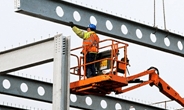Analysis

March 6, 2020
AGC: Construction Unemployment at New February Low
Written by Sandy Williams
The construction industry’s unemployment rate hit a new February low of 5.5 percent, according to an analysis of new government data by the Associated General Contractors of America. Construction employment increased by 42,000 jobs in February and by 223,000, or 3.0 percent, over the past 12 months. AGC officials said some of the gains were attributable to mild winter weather in parts of the country, but were primarily due to strong demand for construction services.
“Contractors are off to a fast start in 2020, adding 91,000 jobs in the first two months—the most in nearly two years,” said Ken Simonson, the association’s chief economist. “Although some of the gains probably reflect unusually mild winter weather in much of the nation, there is no question that contractors have been upbeat about the volume of work available.”
Total construction employment climbed to 7,646,800, the highest level since July 2007, with gains in both residential and nonresidential employment. The 3.0 percent growth in construction employment between February 2019 and February 2020 was nearly double the 1.6 percent increase in total nonfarm payroll employment. Average hourly earnings in construction – a measure of all wages and salaries – increased 3.0 percent over the year to $31.35. That figure was 9.9 percent higher than the private-sector average of $28.52.
Employment data was collected in mid-February before the novel coronavirus began to affect some industries. There have been no reports of construction sites being affected or of projects being deferred or canceled due to the virus, said Simonson. Association officials said it is hard to estimate whether the spreading coronavirus will have a significant impact on future demand for construction or the sector’s employment levels.
“The industry clearly benefitted from strong demand in February, but it is unclear whether and how the coronavirus might impact construction employment,” said Stephen E. Sandherr, the association’s chief executive officer. “Passing new infrastructure measures will support needed fixes to our transportation network while adding a new level of stability in what are likely to be uncertain times.”







